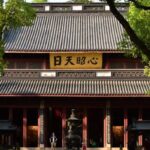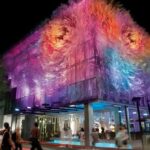Yuejiang Tower is located at the summit of Lion Hill on the southern bank of the Yangtze River, with[...]
Yuejiang Tower is located at the summit of Lion Hill on the southern bank of the Yangtze River, with the city’s moat encircling the hill. The tower, modeled after Ming Dynasty architecture, features red pillars and a roof covered with golden glazed tiles, creating a strikingly vivid appearance. Ascending to the top of Yuejiang Tower offers a panoramic view of the vast Yangtze River, providing a refreshing and exhilarating experience.

The historical context for the construction of Yuejiang Tower dates back to over 600 years ago, initiated by the founding emperor of the Ming Dynasty, Zhu Yuanzhang. Prior to his reign, Zhu Yuanzhang commanded tens of thousands of troops from Lion Hill, defeating the formidable army of 400,000 led by Chen Youliang, thus laying the foundation for the establishment of the Ming Dynasty. After ascending to the throne, Zhu Yuanzhang renamed Lu Long Mountain to Lion Hill and decreed the construction of Yuejiang Tower.
He personally wrote ‘The Record of Yuejiang Tower’ and instructed his scholars to write similar records, which were later included in ‘The Complete Works of Classical Chinese Prose’. Despite two versions of ‘The Record of Yuejiang Tower’ being passed down through generations, the tower itself remained unconstructed for various reasons until it was officially commenced in February 1999 and completed in September 2001 for public access.


The tower stands at a height of 52 meters, with an exterior of four visible stories and an additional three hidden levels, totaling seven floors. Each floor contains exhibits related to the Ming Dynasty. Although these are modern arrangements, the presence of a redwood dragon throne on the first floor, a giant porcelain depicting Zheng He’s voyages to the Western Seas on the third floor, and a golden dragon carved from a whole camphor wood on the ceiling of the fourth floor, adds grandeur to the interior.
On a clear day, visitors can take in the sights of the Yangtze River, the Nanjing Yangtze River Bridge to the north, the Zijinshan (Purple Mountain) to the southeast, and the cityscape of Nanjing. The Yangtze River, bathed in the golden-red light of the setting sun, exudes a gentle warmth.
Tian Fei Palace and Jinghai Temple are located outside the main entrance of the Yuejiang Tower scenic area. Initially, both were constructed by Emperor Yongle of the Ming Dynasty to pray for Zheng He’s safe travels. However, the structures seen today are modern reconstructions. Tian Fei Palace can be visited at will. Jinghai Temple, a site of historical significance as the location where the humiliating ‘Treaty of Nanjing’ was signed, offers visitors the opportunity to explore the Zheng He Memorial Hall and the Treaty of Nanjing Historical Museum. The Tian Fei Palace Stele within the temple is an authentic ancient artifact.
Opening hours are from 08:00 to 17:30 all year round, and from 08:00 to 18:00 on Labor Day.
Preferential policies: Children under 1.4 meters (not including) enter for free. Children/seniors/students over 1.4 meters (including), seniors aged 60 to 69 (inclusive) with ID or senior citizen card, full-time school students, and college/undergraduate students with their student ID enjoy half-price admission. Seniors aged 70 and above (inclusive) with ID or senior citizen card enter for free. Military personnel with valid military ID and disabled individuals with valid disability ID also enter for free.
Service facilities: Luggage storage and stroller rental are available for free. The address is the Visitor Center. Restrooms are located within the scenic area near various facilities such as Shi Ling Yue Jiang, Tian Fei Palace, Shi Ling murals, Zhu Yuanzhang statue, parking lot, Jinghai Temple Memorial Hall, and the entrance to the scenic spots, all clearly marked with signs.
Nursery Room: The park is equipped with a caring nursery room for mothers and infants.
Dining: The park features restaurants located near the south gate of the scenic area and at the entrance, with prominent signs for easy identification.












